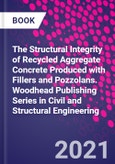The Structural Integrity of Recycled Aggregate Concrete Produced with Fillers and Pozzolans presents a review on the use of by-products, fillers and pozzolanic materials in the development of concrete, with an emphasis on structural integrity. The volume is broken down into key sections, including a review of the types of materials that are used as latent hydraulic supplements, fillers and pozzolans for making recycled aggregate concrete, rheology and hydration phenomenon, the mechanical and microscale nature of concrete, and the impact of fillers and pozzolans on the workability of concrete with case studies. Durability and strength development are also discussed.
The final section looks at issues such as performance effect, LCA, environmental impact, sustainability and cost benefit analysis. With detailed case studies throughout, this volume will provide useful information for all stakeholders involved in the built environment, including materials scientists, civil engineers, builders, architects and policymakers.
Please Note: This is an On Demand product, delivery may take up to 11 working days after payment has been received.
Table of Contents
Section I Potential fillers and pozzolans for recycled aggregate concrete
1. The use of foundry sand for recycled aggregate concrete
2. Influence of fly ash in physical and mechanical properties of recycled aggregate concrete
3. Use of recycled fines from waste concrete as an admixture in new concrete
4. Use of agro-industrial waste as a filler for structural reinforcement mortars
5. Colemanite filler from wastes in recycled concrete
6. Thermal performance of concrete with recycled concrete powder as partial cement replacement and recycled CDW aggregate
7. The use of slags in recycled aggregate concrete
8. The use of rice hush ash in eco-concrete
9. Specialized concrete made of processed biomass ash: lightweight, self-compacting, and geopolymeric concrete
Section II -�Rheology and hydration phenomenon in concrete containing fillers and pozzolans
10. Mineralogy and interfacial transition zone features of recycled aggregate concrete
11. Water requirement for recycled concrete
Section III Mechanical and microscale nature in recycled concrete
12. Mechanical properties of recycled aggregate concrete with bottom ash additions
13. Macroscopic mechanical characterization of self-compacting recycled concrete mixed with natural lime filler
14. Shear strength assessment of reinforced recycled aggregate concrete member
15. Upcycling CO2 for enhanced performance of recycled aggregate concrete and modeling of properties
16. Properties of recycled aggregate concrete designed with equivalent mortar volume method
17. Bending behavior of ecological fiber reinforced concrete
18. A penalized regression approach to prediction of triaxial performance of recycled aggregate concrete
Section IV Issues associated with recycled concrete
19. Overview on environmental impact of recycled aggregate concrete incorporating pozzolans or fillers
20. Durability assessment of recycled aggregate in concrete production
Authors
Paul O. Awoyera Associate Professor, Department of Civil Engineering, Prince Mohammad bin Fahd University, Dhahran, Saudi Arabia. Paul Awoyera is an Associate Professor and a Researcher in the areas of concrete structures, structural retrofitting, sustainable/innovative construction materials, fire resistance, non-destructive testing, data science, and applied Artificial Intelligence. He has over 12 years of experience in structural engineering consulting, teaching, and research. He obtained his PhD Degree in Civil Engineering from Covenant University, Nigeria.Dr. Awoyera completed a one-year Post-Doctoral research, focusing on lightweight composite development using paper and ceramic wastes, at the University of KwaZulu-Natal, Durban, South Africa. He was awarded the prestigious Split-Site PhD Scholarship by the Commonwealth Scholarship Commission in the United Kingdom, which was tenable at the University of Nottingham, United Kingdom.
Dr. Awoyera is a registered engineer with the Council for the Regulation of Engineering in Nigeria (COREN), a member of the International Association for Engineers (IAENG), and a corporate member of the Nigeria Society of Engineers(NSE). He has published over 100 articles in leading publishing outlets and served as the editor/editorial board member and reviewer for numerous international journals. Carlos Thomas Associate Professor, Materials Science and Engineering Laboratory, Civil Engineering School, University of Cantabria, Spain. Carlos Thomas is an Associate Professor at the Materials Science and Engineering Laboratory in the Civil Engineering School of the University of Cantabria, Spain. He received his International PhD with cum Laude and Extraordinary Doctorate Award in 2013. His research activity has focused on the evaluation of construction, demolition and industry wastes for the manufacture of recycled mortars and concrete. In the last five years, he has participated as Principal Investigator in 5 R&D projects and as a researcher in another 10 R&D projects, with both public and private funding, related to recycled materials. He is the author of 20 JCR papers, one of them certified as one of the 25 most downloaded in ScienceDirect, and more than 80 congress communications and conferences. He has undertaken research stays in France, Germany, Brazil, and Portugal, and he is one of the promoters of the "Spanish Recycled Concrete Network". Mehmet Serkan Kirgiz Professor, Istanbul University-Cerrahpa?a, Avcilar, Turkey. Mehmet Serkan Kirgiz is currently a professor at the Trakya University, Turkey. He was previously a professor at the Gazi and Hacettepe Universities, both in Turkey. He has served as Vice Dean, Member of Faculty Management Board, Member of Department Management Board at these institutions. He has authored several peer-reviewed articles and has a national patent on cement manufacturing through the burning of marble powder and brick powder as farina. His major research interests include Ecology based Construction Materials, and Minerals of Raw and By-Product, and upcycling of by-product for sustainable development.








